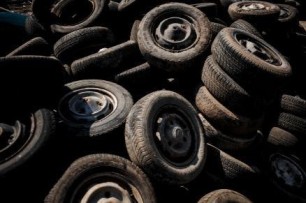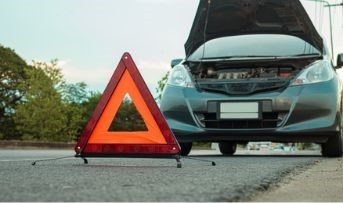General Insurance Blogs, Articles & Updates by - Magma HDI
Have us call you
- RENEW YOUR POLICY
- BUY NEW POLICY

Know if it is worth buying used wheels or not
The tyres and wheels of your car are one of the most used external parts. They sometimes outperform their original capacity resulting in wear and tear due to rough surfaces. If left unnoticed, this can risk the safety of the passengers. So, you must ensure that your tyres are up to the standards as per the regulations set by the manufacturer, the road safety department, and the respective car company.
But what happens if you are facing issues with just one wheel? Do you have to go through the process of replacing all your wheels with new ones? What factors should you be watchful about, and how can you procure used wheels? Don't worry. At the end of this blog, you will know if it is worth buying used wheels or not. So, let's get started.
1. Why do we think it can be worth buying used wheels:
Purchasing used wheels is a good option if your four-wheelers have damaged wheels. This is a significantly cheaper and temporary option than buying a new set of wheels. You can comfortably use those used wheels without burning a hole in your pocket.
2. Understanding the quality of used wheels:
It would be best if you examined the used wheels closely. Be aware of all the cracks, dents, bends, or if any parts and pieces are missing. Surficial damages which are not causing any defects internally can be ignored. There might be issues with the structure of the wheels and rims, which can risk a puncture or blowout on uneven roads and at high speeds.
You can go to a junkyard where they sell used parts. But if you want to avoid the hassle and get quality used wheels and other components, visit an auto parts store that can provide you with top-quality used wheels.
3. Examining the used wheels for damages and defects:
A thorough visual examination is one of the best ways to determine the quality of the used wheels. The second solution is to take a test drive with those wheels. But there are situations where you might not be able to take a test drive, miss out on certain damages, or fail to understand the gravity of what might seem to be surficial damages. You should know other ways to inspect those used wheels in such cases.
If the wheel's outer rim has visible cracks, bends, or dents, it is more likely to get damaged, which might eventually cause a flat tyre. Examine the wheel for corrosion, rust, chipped paint, etc. Used wheels with improper or defective bolt holes should be immediately rejected. Test the wheel by rolling them on an even surface and avoid using them if you see any wobble, misaligned or sideways movement. This usually happens when the wheel is bent but could be difficult to notice during a visual examination.
4. Check the material:
Steel works quite well but affects the car's speed and acceleration since the material is heavy. People often use alloy rims as they are considered a good combination. It upgrades the look of your vehicle to give it a more sporty vibe, gives you a better driving experience, and eventually, helps you save fuel and money. You need to check the tyres' material and immediately reject used wheels with slight damage, corrosion, or rust.
Now you know if it is worth buying used wheels or not. And while we are considering wheels and their alternatives, a sudden accident or ending up in unfortunate circumstances can cause severe damage to your car. Getting those defects fixed can cause a substantial financial burden in times of distress. You need to purchase car insurance which would help you cover the massive costs of fixing and repairing in complex cases. You must explore all your options and buy reliable car insurance India with a reasonable premium and the best benefits.
Click HERE to learn more about the benefits of car insurance India.
Disclaimer: The information provided above is for illustrative purposes only. To get more details, please refer to policy wordings and prospectus before purchasing a policy.

Dealing with a car breakdown? Here’s what you should do
Imagine going on an outstation vacation in your car with your spouse and kids, and your car breaks down midway. You come to an abrupt halt, worried and looking for immediate help to safely get you back to your home or desired destination. Things can be worse when your car breaks down in an emergency.
A car breakdown is always a stressful and harrowing experience. It can be disturbing, especially when you are on a highway. It can leave you helpless and stranded, with usually no assistance in sight for a long distance.
Does this thought scare you? Fret not! Let us go through a few steps you must follow while dealing with a car breakdown. By implementing them, you can rescue yourself from the chaotic situation safely.
1. Pull off the road
If you feel that your car is taking jerks, or is not responding to acceleration or braking, immediately try to pull your vehicle to the side of the road, away from the running traffic. Do the same if you see smoke from the bonnet or inside your car.
Pulling on the side will ensure you are not stuck in the middle of the road with a broken car. It will provide you with some space to look into the breakdown and get it repaired. Also, it is the best action for your safety and your co-passengers.
2. Put on the emergency brakes
Put on the parking or emergency brake when your car is stationary on the side of the road. This will prevent your vehicle from moving forward or backward while repairing it. Be extra careful while parking your car on a hill or a slope. You should turn the steering, so the wheels turn away from the road. Place some bricks or a similar barrier to prevent your car from rolling forward or backward.
3. Switch on your hazard lights
As soon as you have pulled up on the sides, switch on your car's hazard lights. The vehicles approaching the road will know you are stationary and will not line up behind you.
Turning on the hazard lights is extremely important if your car has broken down on a highway. There may not be proper streetlights, and the other vehicles on highways move at high speed, causing a risky situation for you. The hazard lights will announce your stationary position on the road.
4. Use reflective triangles
Your car has reflective triangles in the back for such emergency use. Take them out and keep them at the back or sides of your vehicle. This will make your car visible in the dark and alert the moving traffic.
5. Look for an assistance
After ensuring that you and your car are safe, call the Roadside Assistance number. If you have bought an RSA membership plan, the company will send help to you immediately. You can contact any paid RSA service providers who will also tow your car to the nearest service station for some charges. You can also look for a good car mechanic nearby, ask for his help and get your car started if the glitch is minor. This can be a time-saving and simple solution.
A car breakdown can happen anywhere, anytime, and with anyone. Hence, we should always be mentally prepared for it and take action accordingly. Getting nervous and making hasty decisions can worsen your situation rather than improve it.
You can buy a roadside assistance top-up along with your motor insurance policy which can be immensely helpful in such situations. Choose the motor insurance company that can provide reliable services at the most economical cost and stay tension-free on your drives. Lastly, thoroughly service your car before planning a long-distance journey.
Click HERE to buy coverage from the best motor insurance company.
Disclaimer: The information provided above is for illustrative purposes only. To get more details, please refer to policy wordings and prospectus before purchasing a policy.

Single mother: A health insurance can secure your and your child’s future
Women have surpassed their traditional gender roles and are now leading huge organisations, establishing their start-ups, investing for their future, taking care of their families, and when they decide to become mothers according to their own choices. While we all know how society functions and several stereotypes have been crumbled to the ground by women, we are still far from creating a safer space. But there is no second thought about how the position of women in society has improved over time.
Due to unfortunate circumstances or by choice of living a stress-free life, several women are single mothers today. And most of them hold sole custody of their kid(s). Again, the stigma against single parenting is quite challenging to go through. There are several aspects to ensuring you create a happy life for yourself and your kid. This blog aims to make single mothers understand the importance of health insurance and how it can secure their future and their child’s upbringing. Here’s a guide to achieving that and all you need to know about the topic.
1. Explore all your options.
There are several insurance options in the market. You will see a herd of insurance providers. It would be best to thoroughly research every health insurance- the merits and demerits, terms and conditions, renewal policy, sum insured, service quality, hospitals in the network, trust, and ratings. After all these detailings, if you still feel the process is overwhelming and you cannot differentiate amongst the integral factors, you can consult a financial expert who will help you prioritise your needs and put forth the best options for you.
2. How do you prioritise your requirements?
Health insurance should be at the top of your priority list. And while the details of various types of insurance available in the market can be overwhelming, you need to prioritise your requirements. How can you do that? You need to figure out your insurance coverage, keeping in mind the range of medical expenditures in your location, as geographical factors influence hospital expenses.
While determining the amount for coverage for your health insurance, you need to be careful about the limitations like the hospital expenses, the settlement for the claims regarding the ailments, etc. Health insurance with these restrictions tends to cost you lower than those who endorse full coverage. Listing your needs will help you find the perfect insurance for your necessities.
3. Plan ahead of time.
As a single mother, you have a massive load of responsibilities on your shoulders. It would be best if you secure your future and your child’s/children’s and family’s future from an early stage. Also, you will see a significant increase in medical inflation, impacting health insurance premiums, hospitalisation costs, prices of medical aids and equipment, etc. To combat the unpredictability of this journey called life, you will need to gear up.
You need to look for the additional benefits provided by the various insurance providers and the type of features these benefits carry, for example, daycare, expenditure of an attendant/caretaker, etc. You can explore and analyse the benefits you can get through different added features or insurance for critical illness.
We discussed the perks of health insurance for single mothers. But in no way is it limited to just single parents. Everyone out there requires health insurance to stay monetarily stress-free during difficult phases of life involving health troubles. And with technology, the hassle of buying and renewing insurance is just a matter of a few clicks now! You can purchase or renew health insurance online and be the master of your ship to choose what’s best for you and your family.
Click HERE to learn more about how to renew health insurance online.
Disclaimer: The information provided above is for illustrative purposes only. To get more details, please refer to policy wordings and prospectus before purchasing a policy.

Experiencing a burning sensation in your chest? You may be suffering from acid reflux
Most people may have experienced a burning sensation in their chest at least once. Associated with discomfort and heaviness, the feeling may not appear severe but can be life-threatening. Typically, it is a symptom of gastrointestinal issues and lung problems. Considering the frequency and ubiquitous occurrence of this issue, it becomes essential to buy health insurance online.
There are several reasons for the burning sensation, like stomach ulcers and panic attacks. The likelihood of experiencing a burning feeling in your chest can rise because of reduced blood flow and lung inflammation. But if you feel discomfort in your chest, consult your doctor as soon as possible because it can be related to other severe issues.
But did you know that acid reflux can also be a cause of experiencing discomfort in your chest? Acid reflux is caused by heartburn, a burning sensation mainly because of stomach acid. It can affect people of all ages. Hectic lifestyles and poor health management habits are the contributors to this condition. Many risk factors cause acid reflux, some of which can be serious. It may occur due to smoking, pregnancy, low physical exercise, obesity, etc.
Let's dive deeper to understand acid reflux.
Why does acid reflux happen?
The stomach contains hydrochloric acid, a chemical that reacts with the food and breaks it down. This helps in preventing bacterial growth in the stomach. The ring of the muscle usually acts as a valve that lets food to the stomach but does not back up into the oesophagus. If this valve fails, the stomach content regurgitates into the oesophagus, forming acid reflux. And by this, a person may feel a burning sensation in the chest.
What are the risk factors of acid reflux?
Sometimes, acid reflux happens for absolutely no reason. But there are several risk factors that you should know.
● Active smoking
● Low level of physical exercises
● Pregnancy
● Obesity
● Excessive consumption of caffeine
● Consuming spicy and fatty foods
● Drinking multiple acidic juices
● Eating fast foods
How does acid reflux feel?
Heartburn is the primary symptom of acid reflux. It's a horrific burning sensation that starts in the oesophagus and leads to discomfort in the chest too. It gets worse while lying down and can last for several hours. Sometimes, the stomach fluid can reach the back of the throat, producing a bitter taste and a disturbed peace of mind.
Symptoms of acid reflux
● Heartburn
● A sour, bitter taste in the mouth
● Bloating in the stomach
● Vomit with blood
● A feeling that fluid is stuck in your throat
● Nausea
● Constant weight loss
● Dry cough or sore throat
Causes of acid reflux
Several reasons cause acid reflux, some of which are:
● Eating larger meals at a time and immediately lying down
● Drinking a large amount of alcohol, caffeine, tea, or any acidic juices
● Eating citric foods such as tomatoes, mint, garlic, and spicy foods
● Pregnancy changes
Treatments for acid reflux
There are several ways to avoid acid reflux, including:
● Quit smoking
● Eat smaller meals throughout the day and modify your food types
● Try to sleep in a chair in the daytime for small naps
● Do not wear tight clothes
● Lose weight and change your diet
● Indulge in physical activity
If you have had an acid reflux problem for over a week, you must consult your doctor for medications. It may happen due to several lifestyle changes. It is a common concern but cannot be brushed off, as it may be life-threatening sometimes. In mild cases, simple medicines may resolve your issue. However, for recurring problems, doctors may recommend surgery to cure acid refluxes. Considering the increasing medical inflation and health-related expenses, it is essential to buy health insurance online for your safety against hospitalisation expenses.
Click HERE to buy health insurance online.
Disclaimer: The information provided above is for illustrative purposes only. To get more details, please refer to policy wordings and prospectus before purchasing a policy.


